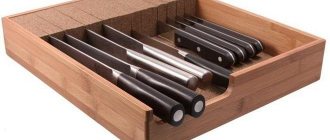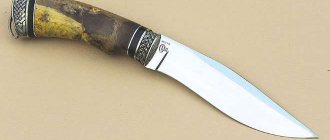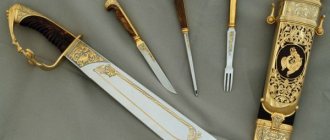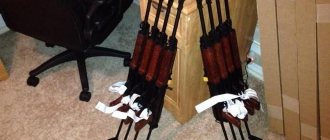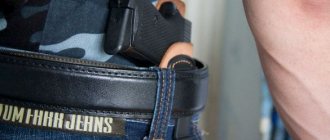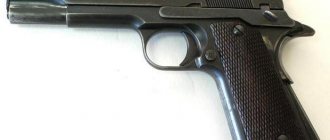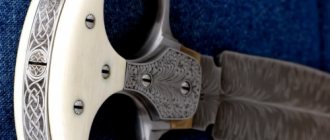The greatest and most significant invention of mankind is a rather simple and today everyday thing, it is neither a wheel nor a microprocessor with computers. And the most common one is a knife. There is no need to be cunning, without this tool, a person simply would not survive. And today, its use has become commonplace, and we do not notice it. But it’s one thing to use it in the kitchen, and another thing – can you carry a knife with you? Let's try to understand this sensitive issue.
Medium size knife.
What knives are not considered bladed weapons by law?
Russian legislation clearly contains definitions of edged weapons. If the blade is not a chemical weapon according to any of the parameters, there will be no problems with the law. Once you use a knife in self-defense, the situation can completely change.
But the topic of the article is different, let's try to figure out whether it is possible to carry a knife with you, and how to do it correctly. In Russia, the culture of wearing these products was spoiled in the 90s and early 2000s. Any blade with a small blade causes people to associate it with banditry and danger. These are echoes of past years, every criminal element kept a knife with him.
There are several GOSTs that stipulate the conditions for cutting, skinning and tourist knives. They do not fall under the section of bladed weapons.
Let's try to highlight the main parameters of the blades that determine the permissibility of wearing a particular knife.
The legislative framework
At the moment, in Russia there are several laws and departmental acts regulating the storage and use of edged weapons. The main one is the law “On Weapons”, which was adopted back in 1996. The norms of the document determine that this type of weapon can be used by civilians and is intended for self-defense. But, at the same time, the types of weapons and areas of their use, as well as individual restrictions, are described.
The second important document is the Criminal Code of the Russian Federation, which contains standards of liability for violation of the basic requirements for the operation of such weapons. Another type of punishment is administrative penalties, which are provided for in the articles of the Code of Administrative Offenses.
The Russian legal system is in many ways similar to the legislation of other CIS countries. In particular, there is almost absolute similarity with the law of Ukraine. A somewhat smaller list of restrictions for owners of combat knives is established in Kazakhstan. And the most severe punishments for violators are fixed by the legislation of Belarus.
What kind of knife are you allowed to carry?
It is necessary to take into account the parameters of the “iron friend”. If it meets one of the criteria, it is “legal” and you can take it with you.
For a better understanding of the criteria, please study the picture below. You may also find the article useful: “What does a knife consist of?”
Concepts and terms for the components of a knife.
Let's try to list them:
- the tip is not designed for piercing, it can also be replaced with a tool (chisel, screwdriver, chisel and more than 3 mm wide);
- a very interesting point: if the height of the tip along a parallel line from the handle along the butt is above 5 mm, there is no limit on the length, and even the finger stop does not play a role;
- if the length of the blade is no more than 18 cm, and the deflection of the butt is more than 5 mm. Again we measure in a straight line from the beginning to the tip - the weapon is acceptable to be worn;
- and provided that the blade is more than 18 cm, then the deflection should be > 10 mm, measured according to the same principle as above;
- the concavity of the butt with a length of less than 18 cm must be at least 5 mm; if the blade is longer, its concavity must be > 10 mm;
- Another interesting point with the hook for ripping skins, if it is no further from the tip than 1/3 - everything is in order, wear it “for health”;
- the bend of the butt blade to the inside, in the form of a rocker arm, when drawing a straight line from the tip to the top point of the handle, must be > 15mm;
- when the butt and blade are brought together at the end of the tip >70 degrees - there are no problems;
- a well-known fact about the blade length being less than 90 mm;
- a butt width of more than 5 mm is also permissible, a well-known law;
- an unsharpened blade, even with dagger bevels, but without a cutting edge, is acceptable to wear. As a rule, these are souvenir specimens;
- a handle less than 7 cm in length will not cause problems with the law;
- With butterfly knives, definitions are very difficult, the only thing that can be said for sure is that the diameter of the barrel-shaped handle at the top is not > 8 mm. Such a blade really deserves special attention, and we won’t dwell on it for now;
- limiter at the blade or recess for fingers, in total not > 5 mm;
- anatomical handle with cutouts for fingers, their depth should be < 4 mm;
- Rockwell hardness < 25 HRC, made of plasticine or something? But it’s possible, period;
- with a developed guard, the thickness of the butt is < 2.5 mm and the length is not > 15 cm;
- a sawed blade removes it from the chemical weapons;
- a product made from various materials, such as aluminum, plastic or wood;
- if the blade dangles in the handle and does not hold during movements, it is also excluded from the CS;
- it is possible to sharpen the false blade on the butt no more than 2/3;
- The use of serrators, saws, etc. on the blade is allowed.
All of the listed restrictions, or, conversely, permits are considered basic according to GOSTs , which remove knives from the category of edged weapons; here are three main ones that determine the main characteristics:
- P51644-2000 “Cutting and skinning knives”;
- P51501-99 “Tourist and special sports knives”;
- R51215-98 “Melee weapons. Terms and Definitions".
It is easy to study the material in depth on the Internet. Manufacturers try to “tailor” the product so that it is not included in the chemical weapons lists.
The knives come with certificates and instructions for use. In real life, it is better to have documents with you: law enforcement officers will have fewer questions. If you are forging blades yourself, be careful, you can “sew on” the production and storage of chemical weapons.
Defining features of edged weapons
A blade is recognized as a bladed weapon based on all its characteristics. The decisive factor is the design purpose for delivering damaging piercing blows without causing damage to the striker. In particular, this is facilitated by a safety handle with a limiter).
If at least one of the signs is missing, the blade does not fall under the definition of “edged weapon”!
| Defining Features | Are not melee weapons | Recognized as a bladed weapon if all the signs are present |
| Length and thickness of the blade (the length is determined from the tip to the stop, or the front end of the blade sleeve, the thickness is greatest in the butt area). | Blade length up to 90 mm inclusive, Thickness up to 2.6 mm or over 6 mm. Handle length less than 70 mm | Blade length over 90 mm, Thickness from 2.6 to 6 mm Handle length over 70 mm |
| The presence of a limiter (one or two) or finger grooves on the handle and their linear parameters | Any deviations from the standards prescribed in GOST for edged weapons (see right column) | The limiter (or two in total) protrudes at least 5 mm from the handle of the knife, the width of the limiter is at least 3.5 mm. The depth of one sub-finger groove on top of the handle is at least 5 mm, each of the grooves on the bottom is at least 4 mm |
| Blade material hardness | Brittle or plastic material – less than 42 units. according to Rockwell | Hardness from 42 HRC (clause 5.2 of GOSTs 2 and 3 from the list) |
| General flimsiness of the structure | The shank is too thin or secured with wax or sealing wax; there is a deep groove sawn along the blade near the handle, causing a break when stabbed | The ability to pierce repeatedly without damaging both the owner’s hand and the integrity of the blade |
| Blade sharpness | - lack of an edge as such, - rounding where the tip should have been, - a sharpened edge for a chisel or screwdriver with an area of at least 3 mm, - large, at least 70 degrees, vanishing angle of the blade and butt, — blade thickness more than 6 mm, - no signs of any sharpening. | According to GOST, a sharpened knife should cut a birch branch with a thickness of 10-12 mm with a humidity of about 12% 5-6 times, leaving a smooth, burr-free cut. Law enforcement agencies tend to define sharpening of a knife as simply removing the cutting edge. |
Let us mention one of the common myths “presented” by police officers to owners of knives. The concept of “ blood flow ” (officially – dol, a groove along the edge of the blade) is unacceptable for use, see clause 6.1.1.5.1 of GOST R 51215-98. “The weapon is cold. Terms and Definitions". Dole is in no way a defining feature of a bladed weapon.
What knives are prohibited in Russia
The topic of “allowed/prohibited” is very “slippery”. Everywhere there is a rather thin line, counted in millimeters. There are blades where even a non-specialist can determine that this is really a murder weapon.
Knife banned in Russia.
Let's try to look at specific examples of prohibited knives in the Russian Federation:
- Dagger-type knives are prohibited in Russia; they are considered edged weapons. But you need to take into account some nuances. Take a blade with a dagger type of sharpening, the cutting edge on one side, and on the other - the false blade is sharpened by 1/3, the tool will pass according to the law. But it’s worth sharpening it even with a serrator as a continuation of the false blade - that’s it, it’s cold. Such blades are permitted for hunting or fishing. Which, accordingly, requires special permission.
- Experts argued for a long time and decided what to do with the butterfly knife and what category to classify it into. This is a weapon of criminal elements of the 90s, and the law was adopted precisely at that time. In short, in the Russian Federation, knives and blades whose blades extend due to gravity or accelerated movement and are fixed are prohibited for circulation. With the condition that the blade is larger than 9 cm. Such a product is illegal.
- Another interesting category related to edged weapons is stilettos. By definition, it is a piercing product, and there is no cutting edge. But having sharpened one side and having a length of less than 15 cm, you still remain legal. Manufacturers put special limiters on them so as not to go beyond the limits.
- The law of the Russian Federation does not really like any mechanics; kick-outs and front-ends with a blade length of more than 9 cm are automatically classified as chemical weapons. Most likely, this is due to the same principles as with “butterflies”.
Please note that laws vary from country to country. The import and export of piercing and cutting objects is regulated. Research the laws of the country you are trying to enter. Purchase products from official representatives with a set of documents.
How to understand that a knife is a bladed weapon
In the photo, the large knife at the top is not a bladed weapon. At the same time, a small knife from Ka-Bar is a bladed weapon.
Unfortunately, without an examination or a certificate of compliance with any GOST, it is impossible to understand whether a knife is a bladed weapon or not.
In Russia there is GOST R 51215-98 “Cold weapons. Terms and definitions" which describes all the requirements for edged weapons:
Steel arms
Quote from this GOST:
SIGNS ON THE BASIS OF WHICH PRODUCTS ARE CLASSIFIED AS EDGE WEAPONS
B.1 The presence of structural elements in the product with a tip and (or) one (two) blade (blades) and (or) concentrated mass and a hard surface.
B.2 Compliance of the weight and overall dimensions of the product with the physical capabilities of a person, which allows them to wear these products and operate them manually.
B.3 Sufficient human muscular energy to effectively defeat a living target with a single use of the product.
B.4 Lack of a direct and convenient way to use the product to perform household or industrial work.
B.5 The presence of structural elements that facilitate the use of the product to hit a target and interfere with the performance of household or industrial work.
B.6 The product has strength and reliability that is excessive for its use as a tool when performing household work.
As we can see, according to this GOST, theoretically any knife can be classified as a bladed weapon, therefore the Weapons Law (Article 1) has the following clause:
- Weapons do not include products certified as household and industrial products, sports equipment that is structurally similar to weapons (hereinafter referred to as products structurally similar to weapons).
Accordingly, knives sold in the Russian Federation must have certificates that are provided by the seller or manufacturer when selling the knife. If he doesn’t have them, then at a minimum he violates the rules of trade and the Law on Consumer Rights, and at a maximum 222 of the Criminal Code of the Russian Federation if his knife turns out to be a weapon.
The Weapons Law does not classify household products as weapons, which include most knives, and they are freely sold in our stores.
These products and knives are classified by the following GOSTs (for knives only, we do not consider other products in this article):
We recommend: How to catch pike perch in summer
GOST R 51015-97 Household and special knives.
GOST R 51501-99 Touring and special sports knives.
GOST R 51548-2000 Survival knives.
GOST R 51644-2000 Cutting and skinning knives.
GOST 4230-93 Garden knives.
GOST 7013-67 Measuring knives
and others (the list is quite large, for example, medical, vaccination and others, most citizens rarely encounter these, so we do not provide links to GOSTs for them; if desired, they can be easily found on legal portals).
Accordingly, if your knife falls under one of these GOSTs, then it is not a bladed weapon.
Separately, in the Weapons Law there is such a term as products structurally similar to weapons, which do not relate to edged weapons. Numerous naval dirks and bayonet knives from a Kalashnikov assault rifle are now sold under this formulation.
How not to accidentally buy edged weapons:
Strange as it may sound, in the Russian Federation you can accidentally buy a weapon, namely a cold weapon, while neither the seller nor the buyer may have any idea what they are actually buying or selling, but this does not exempt either one from responsibility, so it is necessary know the following:
- When buying a knife in a store, if you have doubts about it, ask for a certificate for the knife from the seller, which states which class and GOST it belongs to. Although the likelihood of buying a bladed weapon in an ordinary non-weapons store is practically zero;
- Do not buy knives from hand, or at bargain shops, if there is no certificate, the same applies to homemade knives, first look at the GOST standards for edged weapons;
- Theoretically, it is impossible to buy edged weapons in a regular store, since only specialized stores with the appropriate license issued by the Russian Guard can sell weapons, and they cannot sell them without you having a license to carry and store hunting weapons and a hunting license, or other permits that allow you to store and purchase edged weapons.
In a situation where you have a knife, but there is no certificate for it, you will have to independently study the GOSTs above and find out which class it belongs to.
Advice:
If your knife is not a combat knife (for example, attached to a weapon as a bayonet, a naval dagger), then you can analyze this GOST R 51500-99 Hunting knives and daggers. If your knife does not fall under this GOST, then there is no need to worry too much, most likely it is not a bladed weapon.
Please note that some folding knives fall into the bladed weapons category.
The Weapons Law (Article 6) prohibits the circulation of bladed weapons and knives, the blades and blades of which are either automatically removed from the handle when a button or lever is pressed and fixed by them, or extended due to gravity or accelerated movement and automatically fixed, depending on the length of the blade and blades over 90 mm.
There are no GOST standards for combat knives in the public domain, if they exist at all; foreign-made combat knives are certified as hunting bladed weapons.
Law on carrying bladed weapons
Anyone can obtain a license to carry chemical weapons. Provided that the citizen is not registered in a psychoneurological or drug treatment institution. A license is also issued to paramilitary organizations for a period of 5 years. A license is not required for sporting weapons. The law defines the circle of persons who have the right to carry bladed weapons:
- persons engaged in hunting;
- officials in the performance of their duties;
- athletes at competitions;
- retired military personnel who have chemical weapons as a trophy or souvenir and have received permission to carry it;
- citizens for self-defense when transporting goods;
- persons at cultural events (antiques).
Regarding the last point, a license is required to wear it with the costumes of the peoples of Russia and the uniform of the Cossacks. People with a firearms license can also purchase cold ones.
At what age can you carry edged weapons?
Having carefully studied the specialized forums, we were surprised. Many people teach children to use knives from a very early age. At 2-3 years old, they demonstrate which side it “pricks” on, and which side it needs to be held on so as not to get hurt. By the age of 4-5, small knives are made and children are taught to use them with various fruits and vegetables.
Kitchen knife.
They show that it is impossible to cut metal and stones. This mainly concerns boys, but girls are also involved. I was pleased with this upbringing and culture of handling a knife. The impression is that you didn’t read a Russian forum. This person wants to shout - Bravo! And the rest follow the advice.
Carrying chemical weapons is allowed after obtaining a license, respectively, from 18 years of age. If the law is broken, parents will be held accountable. Dear children, do not let your loved ones down.
How to obtain permission for a storage and carrying license
To obtain a license to carry and store chemical weapons, you will first need to collect a certain package of documents. The main documents, and it is unlikely that others will be required, look like this:
- Medical certificate with all notes.
- The application form can be obtained online.
- Photos 3x4 2 pcs.
- Inspection report of the storage location.
- Passport and its copy.
- Receipt for payment of state duty.
Review of the application with all the documents takes approximately 1 month. The obtained permit in Russia is valid for 5 years.
How to buy a hunting knife legally
Having received a license to carry and store hunting weapons, you will be issued a hunting license. To purchase a specific type of bladed weapon, you need approval from the licensing department (LRO) and a special right to purchase it. Now we go to the store, a note about the purchase is placed on the hunting ticket. Then, having received the item in your hands, it must be certified by law enforcement agencies. They will issue a special document with a note about the registration of the blade in the Department of Internal Affairs. It gives the right to carry and store a knife.
Hunting knife.
It is not difficult to acquire a hunting blade that is not a melee weapon. You will not need to obtain certificates or permits. In the store, the knife will be accompanied by documents that give you the right to carry the product with you. They will be needed to present to law enforcement if required. It's better to always have them with you.
Peculiarities of carrying knives on the territory of the Russian Federation
On the territory of Russia, you can carry knives anywhere and any kind, with the exception of knives related to edged weapons. How you can carry edged weapons is described in the Weapons Law.
You can only carry edged weapons with a Cossack uniform and national costumes, but you must also have the appropriate documents for this. Hunting edged weapons, if you have permits, can only be carried in hunting grounds; in other cases, only their transportation is permitted.
Separate acts and orders may prohibit the carrying of knives (piercing and cutting objects) in places where any organized events are held or at sensitive facilities.
If you have a knife while attending such an event, the organizers have the right not to let you into it or ask you to leave this place, or hand over the knife for safekeeping.
You do not have the right to confiscate or take away your property, which is a knife.
If you were stopped by a police officer or the National Guard and decided legally search your belongings or search your property, and found a knife on you, then several options are possible:
- he can confiscate it before the end of the investigative actions, and then return it; if he does not return it, then this is an official crime for which he will have to bear responsibility;
- if he believes that this is a bladed weapon, he must send it for examination, which will decide whether it is one or not.
If the examination recognizes your knife as a bladed weapon, and you do not have permits to carry it, then you face punishment under Article 20.8 of the Code of Administrative Offenses of the Russian Federation, Part 4 Violation of the rules for storing, carrying or destroying weapons and ammunition by citizens.
A fine of 500 to 2000 rubles; if you have permission to carry and store weapons, then temporary deprivation of this right is possible.
Please note that the search, examination and seizure must be carried out within the framework of current legislation and recorded in appropriate protocols , which can subsequently be appealed. Do not forget about Article 51 of the Constitution and the right to the assistance of a lawyer or defender. payment for the services of a defender or lawyer through the court from the organization that carried out unlawful actions against you, if they were truly unlawful.
Two inconspicuous and small knives on top are edged weapons. The second knife from the top in some countries is considered a military weapon and is used in the armed forces. At the same time, large and no less durable folding knives from below are not edged weapons and they can be carried freely throughout the country.
Carrying hunting knives is only possible in hunting areas if you have a permit for a hunting weapon and a hunting license. In other places, if you have these documents, you can transport it.
Important: violation of the rules for transporting and carrying hunting knives is punishable under Article 20.8 Part 4 of the Code of Administrative Offenses of the Russian Federation, which, in addition to a fine, provides for temporary deprivation of the right to store and carry weapons, so be careful if you decide to take a hunting knife fishing and decide to hang it on your belt, and not left in the sheath in the backpack.
There is no need to carry or keep any certificates stating that a knife is not a bladed weapon, no law forces you to do this, you are not obliged to present these papers to police officers or other authorities, and they are not documents for them. If a knife was confiscated from you on suspicion of being a bladed weapon, then the document will be the result of a forensic examination, and not your certificate.
Knives on public transport
Traveling with a knife that is not a bladed weapon in the subway, trains and other types of transport, with the exception of an airplane, is permitted freely.
If you are harassed by security officers (usually in the subway or at train stations), calmly write a complaint against them to this organization, to the organization that issued them a license for security activities and to the prosecutor's office for exceeding their official duties and illegally restricting your rights.
If the knife is a bladed weapon, you only have the right to transport it in any type of public transport if you have the appropriate permit; for hunting knives, this is a hunting ticket and a permit to store and carry firearms.
In this case, you are required to present these documents only to the police officer, and not to security officers.
Do not forget about your obligation to prevent access to weapons by unauthorized persons; this also applies to bladed weapons, so if you let them go on the X-ray tape without being seen, you could theoretically incur administrative liability.
To avoid this situation, ask to invite a police officer, show him your permits and go freely to the station or metro.
Knives on the plane
When transporting bladed weapons by plane, it is better to first call the airport security service and find out how it is easier for you to transport your hunting knife. Most likely, you will be asked to check it either as luggage or to security, who will load it onto the plane, and you will receive it upon arrival at your destination.
When handing over or transporting bladed weapons in your luggage, do not forget that you are losing control over them and giving access to the weapon to unauthorized persons, for which you will face liability. It is better to hand it over to airport security and receive it from them upon arrival at your destination.
Regular knives are carried in checked luggage. You will not be allowed on board a plane with a knife, and this is legal.
What are the differences between household knives and edged weapons?
In principle, knives are divided into household products and edged weapons. The weapon is structurally designed to hit a target using human muscle power.
Due to their design features, household knives are not intended for forceful destruction of targets. In skillful or playful hands, of course, a household product can act as a bladed weapon, but in this case we are talking specifically about the design features that determine the specialization of a particular knife.
An example of a household knife.
In accordance with GOST, knives having the following parameters are not considered cold bladed tools:
- Models without a point. It is difficult to stab with such a knife, since its tip is rounded. Such an object can perform, for example, the function of a screwdriver.
- If the blade is less than 9 cm long.
- The tip is located half a centimeter above the butt. In this case it is also difficult to strike.
- A knife with a blade half a centimeter below the butt for a length of up to 18 cm and 1 cm below for a length of more than 18 cm.
- Items with a handle less than 7 cm.
- There is a hook on the butt.
- The thickness is more than half a centimeter.
- Models whose blades are not sharpened.
- The material of the knife is not strong enough.
- With a blade length of up to 18 cm, the spine is concave by half a centimeter and by 1 cm at 18 cm or more.
These parameters clearly indicate the differences between a simple knife and a combat one. Before purchasing, it is advisable to measure the key characteristics of the cutting tool, so as not to have problems with the law in the future. It should be taken into account that legislative documents undergo adjustments and additions from time to time.
Is there criminal liability for possession of bladed weapons?
People have different attitudes to the issue of storing and carrying any weapons, and the opinions of officials and law enforcement officers also differ. Some believe that a person has the right to self-defense within the limits established by law, others are confident that our society is not yet ready for this.
Meanwhile, legislators in 2003 made a significant change, replacing in most cases criminal liability for carrying bladed weapons with administrative punishment. Let's figure out what is considered a chemical weapon, what documents allow you to have it, and what liability is provided by law for violating the rules for handling it.
What can be considered a cold weapon?
It cannot be said unequivocally that owners of bladed weapons are protected from criminal attacks, and why they carry knives and stilettos, in principle. In any case, you need to know whether your favorite pocket knife is a bladed weapon. To do this, we suggest that you familiarize yourself with the main signs by which you can distinguish a table knife from a prohibited weapon.
According to Article 6 of Federal Law No. 162, a blade is considered cold:
- if the length of its working surface exceeds 9 centimeters.
- if the blade thickness exceeds 2.4 millimeters.
- if the product has a steel hardness of more than 25 Rockwell.
- the presence of a special finger stop, a throw-out mechanism or a retractable device operating under the influence of gravity with a lock.
- the presence of an ending convenient for piercing blows.
- if the blade roll does not exceed 9 millimeters.
- if the angle between the base of the knife (butt) and the blade is no more than 70 degrees.
It should be noted that the presence of one of the listed signs is a reason to detain the owner of a piercing object.
Knives, including Finnish knives, dirks, daggers and stilettos, may be subject to restrictions. Owners of battle axes, checkers, sabers and swords must also adhere to the rules of storage and carrying.
Also included in the list of prohibited items are meerkens, brass knuckles and other items that can be used to stab, cut, chop and deliver crushing blows that can cause serious injuries, including those incompatible with life.
According to GOST, household items include a folding pocket knife no more than 15 centimeters long.
Owners of karambits, penknives, kitchen knives, shoemakers, garden knives and scissors, which are not considered edged weapons, should not worry, but you should not carry these items unnecessarily; do not forget that airports have their own rules.
Who has the right to carry bladed weapons?
Manufacturers of chemical weapons are required to go through a certification procedure. This applies to both products manufactured on the territory of the Russian Federation and those that cross the state border and are manufactured abroad.
The certificate, according to GOST-R, indicates which category the item belongs to, and the missing information is contained in the information sheet attached to the main document.
When a suspect is detained for illegally carrying a knife or stiletto, the suspicious item is sent for certification or a forensic examination is ordered. Wearing chemical weapons is permitted only in two cases:
- If you have permission to store hunting weapons. By presenting it, the hunter can buy a special hunting knife, and the buyer puts a note about the purchase on the permit. Thus, in accordance with the provisions of Article 13 of the law, a permit is not issued to store and carry chemical weapons, but it is allowed to store and use hunting weapons for their intended purpose.
- If edged weapons are an integral part of the national costume, and in this case, in order to purchase a checker, saber or dagger, in accordance with the 3rd and 13th articles of the law “On Weapons”, a special license is purchased (this is what the Kuban, Don and Ural Cossacks do, to example).
In other cases, and in accordance with the provisions of Federal Law No. 162 of December 8, 2003, carrying knives is prohibited by law. The exceptions are law enforcement officers during their official duties, hunters during hunting, and athletes during sports competitions.
Who will not sell the blade to?
It turns out that if you have the appropriate permit or license, you can have edged weapons, but this does not mean that absolutely all Russians will be able to use it. There is a category of persons who will not be issued a permit document under any circumstances. You won't be able to get permission;
- for those who have not reached the age of eighteen.
- if a person has medical contraindications or cannot provide a certificate confirming the absence of such contraindications.
- prisoners or people with an outstanding criminal record, if this concerns crimes committed intentionally.
- in the absence of a permanent place of registration.
- if buying a weapon is prohibited by the court.
- if a person has been charged with drug use at least once.
Apart from those who are allowed to carry bladed weapons, no one else can do this. It is not permitted by law to use it for self-defense, and if you carry chemical weapons, you must have permission with you. If this is not the case, in principle, you will have to answer under Art. 20.8 of the Code of Administrative Offences.
How to get permission
If you decide to purchase chemical weapons, be sure to obtain a special permit. It is issued by the permitting service at the Department of Internal Affairs; to do this, it is enough to prepare a package of documents:
- passport.
- medical report.
- a document confirming the fact of payment of the state duty.
- two photographs of the specified size.
- application of the established form.
Even if you receive permission to store and carry chemical weapons, you still do not have the legal right to do so. There is still a certification process for legally purchased weapons.
And remember that even having a permit does not give you the right to use bladed weapons for self-defense; do not forget also about the responsibility for lack of permission.
Penalty for lack of permission
- a fine of 500-2 thousand rubles.
- paid seizure of bladed weapons, in this case the weapon is sold, and the money for it (less expenses incurred during the sale) is returned to the owner.
If we are talking about the sale of weapons, then this type of activity requires obtaining a license, and without one, selling knives and blades recognized as edged weapons is not allowed. For this you can get up to two years in prison, while paying a fine of up to 80 thousand rubles. There is also criminal liability for the illegal manufacture of bladed weapons.
If you want to make a good knife for yourself, first study the signs of chemical weapons from the point of view of the law, also read the provisions of some GOST-R, from which you will learn which piercing and cutting objects can be made, and which are taboo.
Source: https://kemprogress.ru/est-li-ugolovnaya-otvetstvennost-za-hranenie-holodnogo-oruzhiya/
How to wear and store correctly
Carrying a knife is not regulated in Russian legislation. There are places where it is better not to go with a blade. The law does not prohibit doing this, but there is simply a security service or just common sense. Places with large crowds of people, concerts, sporting events, etc. SB cannot be passed with a blade.
It's better to leave it at home or in the car. If you were smart enough to bring a knife to such an event, you don’t need to “shine” it. In the Russian Federation, wearing it is not regulated, but you should not walk around with a blade “for show”. Attracting attention to yourself.
It looks defiant and risks communication with law enforcement agencies. If you hide a knife in your sleeve or behind your back, if something happens, you may be accused of secrecy. It’s easier to hang it on your belt and cover it with a piece of clothing.
Difficulties may arise if you decide to travel by air. Having all the documents for the knives, present them, and the products must be checked in as luggage. You cannot bring even the slightest object of a piercing or cutting nature into the salon. In a situation where there is no documentation for the blade, it will be confiscated from you and placed in temporary storage.
Box for storing knives.
And upon return they will be required to give it back upon presentation of all papers. It happens in Russia, a knife can get lost, seeing it again is a question. There will be no problems with sea transport. The main thing is not to display your “pointy-nosed friend” in front of everyone, and when talking with law enforcement officers, behave with dignity. Everything will be resolved in a positive way.
Responsibility for illegal possession, carrying or manufacturing
There is no point in citing articles: No. 222 and No. 223 of the Criminal Code of the Russian Federation; they are freely available on the Internet. If a crime has occurred, then there is no point in conducting an examination; a person was killed with this object and that’s all. Take the situation of simply carrying a blade without documents, law enforcement agencies love to conduct various checks.
This is especially true for souvenirs and homemade products. Be careful and vigilant with such items. If it is proven that this is a chemical weapon, according to the law, for illegal carrying or storage, a fine of 500 to 200 rubles and deprivation of a permit for a period of 1 year are imposed.
With production and sales, there are other significant difficulties in the form of: compulsory labor for up to 480 hours, correctional labor for up to 2 years, or imprisonment with a fine of 80 thousand rubles. or without it. According to law enforcement officers themselves, such cases rarely reach actual prison terms.
Responsibility for carrying and storing bladed weapons
Some argue that there is criminal liability for the illegal use of sharp and cutting objects, while others say that you can get away with a fine.
In what cases does a person face an article of the Criminal Code of the Russian Federation for carrying a bladed weapon, and when can he get off with a fine?
What does edged weapon mean?
This concept includes various types of weapons that do not use flammable explosives, gas or electricity. In this regard, this type of weapon includes swords, stilettos, pikes, rapiers, swords, daggers, bayonets, and knives. Melee weapons also include a police baton, kubotan, etc.
Distinctive characteristics
Many people believe that any household knife can become a bladed weapon the moment a person has to use it against another person. However, it is not.
A household item will never be a bladed weapon due to its use. An ordinary knife, when used against a person, becomes a crime weapon. But this does not mean that the knife becomes a bladed weapon.
Signs of edged weapons:
- developed emphasis;
- comfortable handle, specially designed so that the hand does not slip;
- blade length more than 9 cm.
Karambit in the Russian Federation is not considered a melee weapon for the reason that it has a concave cutting edge. A knife with a hook at the end is also not a bladed weapon.
According to GOSTs of the Russian Federation, folding knives with a blade length of less than 150 mm are not classified as edged weapons. If the length of the blade is less than 15 cm, then such a knife will be classified as a household appliance. Fixed blade knives (non-folding knives) are not always considered edged weapons.
Experts define the type of knife as follows: if the rest ensures the safety of the hand when piercing a pine board, then such a knife is classified as a bladed weapon. If the emphasis is weak and it does not matter what the length of the blade is, then such a knife will also be classified as a household item.
What threatens a person for selling piercing objects? Responsibility for illegal storage, sale
According to Art. 222 of the Criminal Code of the Russian Federation, the sanction for the storage and sale of knives and other types of bladed weapons is as follows:
- restriction of freedom for up to 3 years;
- engaging a convicted person in paid work in accordance with a court order for a period of up to 4 years;
- forced isolation of a convicted person for up to 4 years with or without a fine of up to 80 thousand rubles.
If a group of people is involved in storing piercing and cutting objects, then they face punishment in the form of imprisonment for a term of 2-6 years with or without a fine (up to 100 thousand rubles).
If an organized group is engaged in illegal possession of weapons, then each of its members may face a sentence of imprisonment for a period of 5 to 8 years with or without a fine (from 100 to 200 thousand rubles).
Administrative responsibility for carrying bladed weapons
The article of the law reads as follows: “Violation of the rules for storing and carrying weapons by citizens” (Article 20.8 of the Code of Administrative Offenses of the Russian Federation) and implies that for such a violation the violator may face liability in the form of:
- a fine in the amount of 500 rubles to 2 thousand rubles;
- deprivation of the right to purchase and store weapons for up to 1 year.
Rules for carrying edged weapons in Russia
“Carrying” means having a piercing object in clothing or on the body, which is equivalent to having it in a bag or briefcase. Transporting weapons is equivalent to transportation. For example, a knife in the glove compartment of a car, in a trunk or in the trunk is transportation of bladed weapons.
Citizens of the Russian Federation have the right to transport (transport) cutting and piercing weapons that legally belong to them in an amount of no more than 5 units.
Melee weapons are recognized as such only based on certification results. If a person does not have permission for it, then he may face punishment.
Citizens of the Russian Federation have the right to carry edged weapons only in two cases:
- If a person who wants to purchase such a weapon has a permit to carry a hunting weapon. When purchasing a knife, there must be an entry on the hunting license.
- If a person decides to buy a cutting object in order to complement the Cossack image, that is, he wants to purchase a weapon as an attribute for the national costume.
In all other cases, carrying edged weapons in Russia is prohibited.
In what cases is it legal to carry bladed weapons?
According to Law No. 150-FZ of December 13, 1996, carrying bladed weapons is permitted:
- hunters on the hunt;
- officials on duty;
- during cultural events - we are talking about antique weapons;
- athletes at competitions;
- those who have permission to permanently carry weapons.
According to the laws of the Russian Federation, carrying bladed weapons for self-defense is prohibited. If a person has a weapons permit, he must carry it along with his documents.
When purchasing any type of bladed weapon, the buyer must request from the seller a certificate for the product, as well as an information sheet containing information about the item being purchased.
Permission to carry knives in Russia
If you are seriously thinking about buying a knife that falls into the category of edged weapons, then you need to obtain special permission. It can be obtained at your place of residence at the police department.
What documents need to be submitted to the Department of Internal Affairs? To receive such a document, a person must submit:
- application completed accordingly;
- medical expert opinion that the applicant has the right to use bladed weapons;
- original and copy of passport;
- standard size photo in duplicate;
- receipt of payment of the state fee for the service.
When the ATS authorities issue a permit to carry bladed weapons, it will be necessary to certify the purchased item with the certification authorities.
When receiving permission to carry a knife, you cannot say that you will use it for self-defense.
Who is prohibited from purchasing edged weapons?
A license to carry will not be issued in the following cases:
- if the person is under 18 years of age;
- the person will not provide a medical certificate confirming that there are no contraindications to owning a weapon;
- the person has an outstanding conviction for a crime that he committed intentionally;
- the person was brought to administrative responsibility twice in a year;
- the person does not have a permanent place of residence;
- by a court decision, a person is prohibited from buying edged and other weapons;
- the person has previously been punished for drug use.
